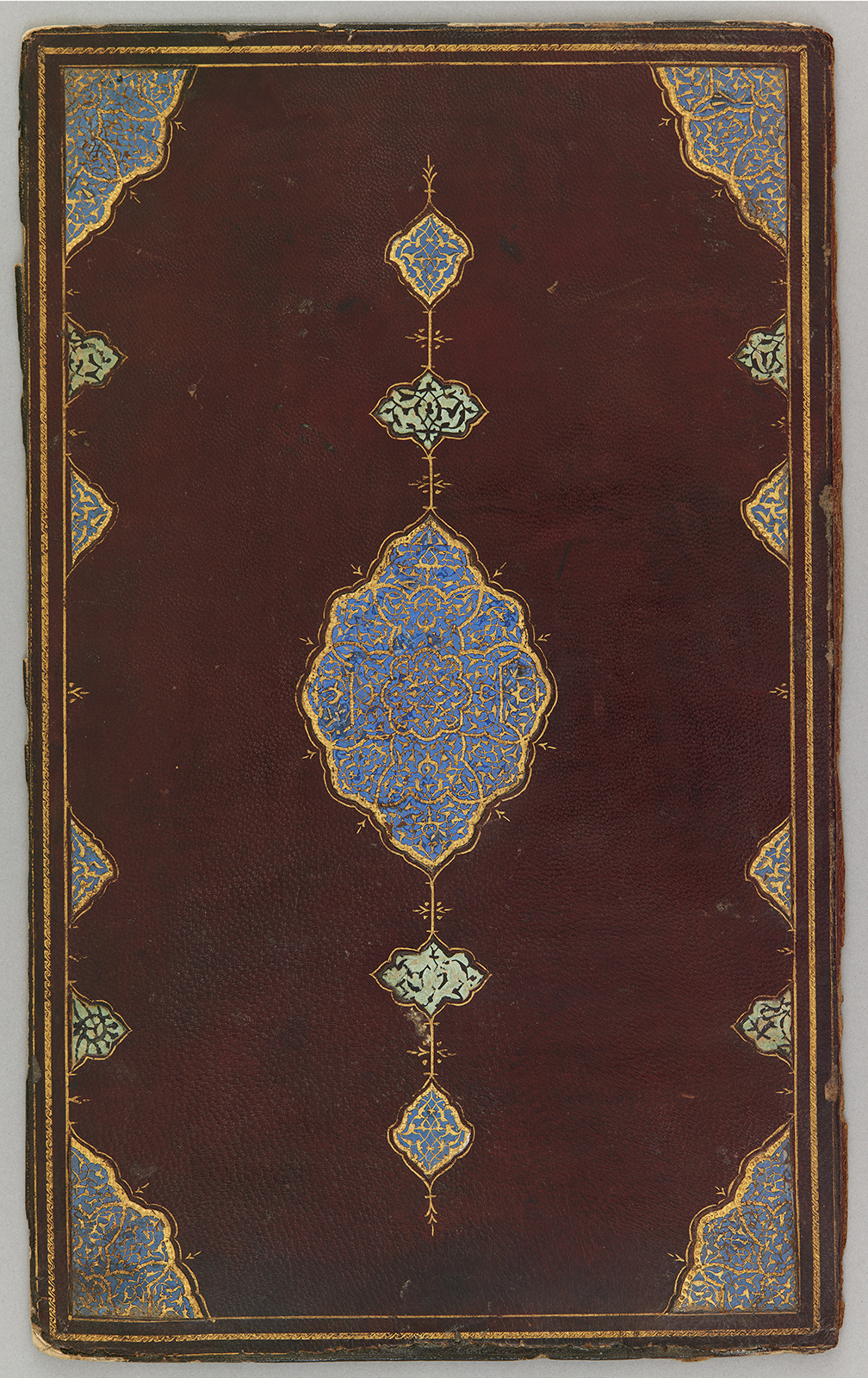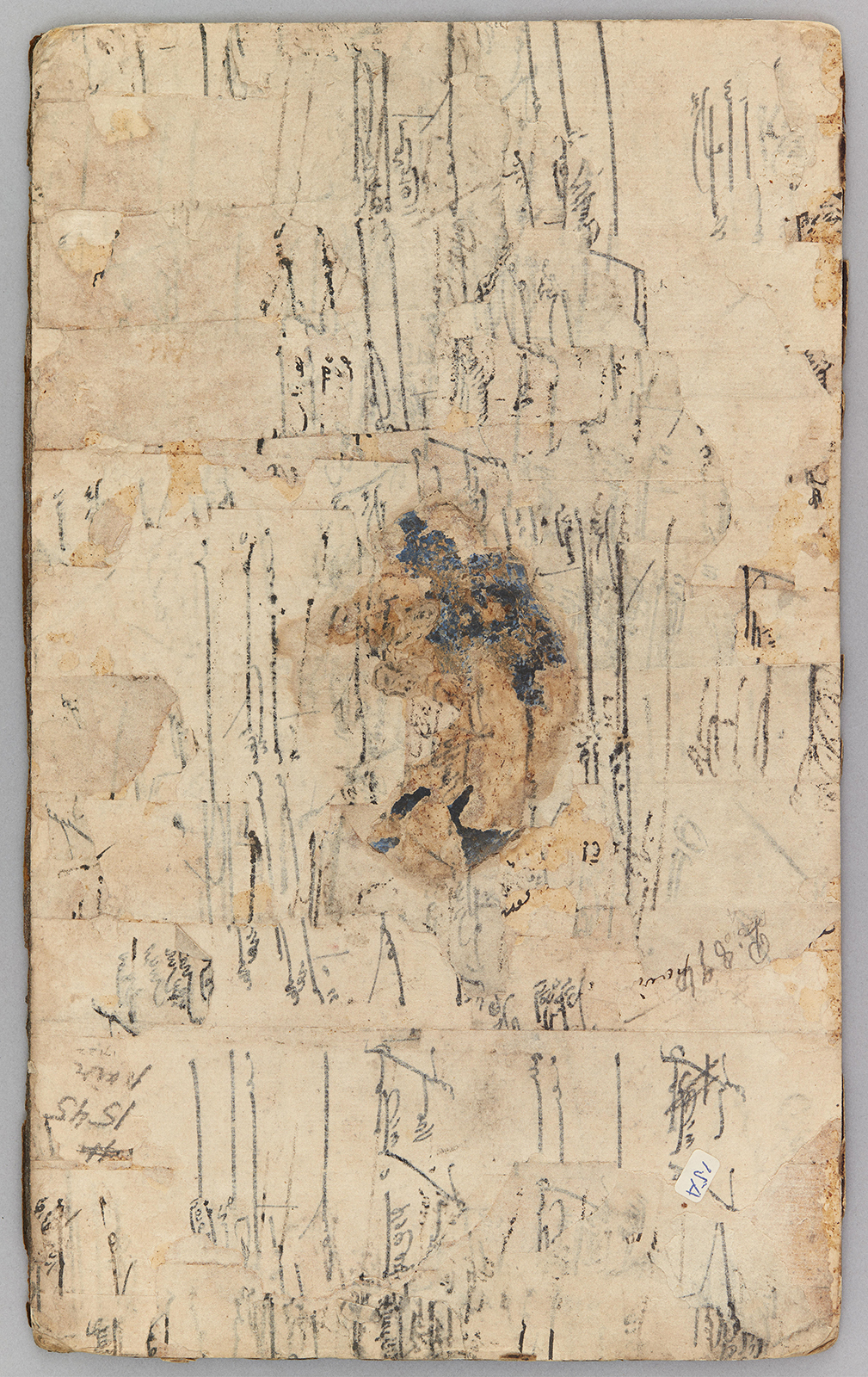Click on the image to zoom
Binding, upper and lower doublures and pasteboard skeleton outer cover
- Accession Number:AKM983
- Place:Iran, possibly Herat
- Dimensions:35 x 21.6 cm
- Date:ca. 1520
- Materials and Technique:Leather, pasteboard, gold, coloured paints
Durable yet easily decorated, leather presented an ideal material for protecting Islamic manuscripts. Some particularly fine bindings executed in the 15th century even featured different designs on the upper and lower covers.[1] Delicate leather filigree was often reserved for inner covers (doublures), where it would be less susceptible to damage.
Further Reading
The light chestnut-coloured doublures are decorated with a vertically aligned oval medallion with pendants and cartouches, and cornerpieces with pendants and cartouches. Painted blue and green, the ground of these motifs is divided into compartments by gilded filigree bands. The compartments are in turn decorated with gilded leather filigree in various leaf-like scrollwork patterns (evoking the rumi motif). Bindings with similarly decorated doublures are found on books produced in late 15th-century Herat under Timurid rule or in early 16th-century Herat and Tabriz under the Safavids.[2]
Beneath these doublures can be seen pasteboard sheets that formed the skeleton of the binding. As traces of writing on these sheets reveal, the pasteboard was made from a pile of used sheets of paper squeezed in a press.[3] The original leather facing must have been peeled off the pasteboard skeleton and used elsewhere. The covers of bindings with doublures of this kind were decorated with landscapes featuring animal figures worked either in the lacquer technique or by stamping and tooling.[4]
- Zeren Tanındı
Notes
[1] Oktay Aslanapa, “The Art of Bookbinding,” figs. 38, 48, 51; Julian Raby and Zeren Tanındı, Turkish Book Binding in the 15th Century. The Foundation of an Ottoman Court Style, 106–25, cat. 1–4.
[2] Peter J. Chelkowski and Priscilla P. Soucek, Mirror of the Invisible World, 11–12.
[3] For a similar example of pasteboard, see Museum für Kunsthandwerk, Turkische Kunst und Kultur aus osmanischer Zeit. Ausstellungskatalog, 110, cat. 1/92.
[4] Zeren Tanındı, “Safavid Bookbinding,” 160, 166–68.
References
Aslanapa, Oktay. “The Art of Bookbinding.” The Arts of the Book in Central Asia, 14th–16th Centuries, ed. Basil Gray. Paris and London: UNESCO/Serindia Publications, 1979, 59–92. ISBN: 9780877731658
Chelkowski, Peter J. and Priscilla P. Soucek. Mirror of the Invisible World. Tales from the Khamseh of Nizami. New York: Metropolitan Museum of Art, 1975. ISBN: 0870991426
Museum für Kunsthandwerk. Turkische Kunst und Kultur aus osmanischer Zeit. Ausstellungskatalog. Frankfurt: Aurel Bongers, 1985. ISBN: 9783764703691
Raby, Julian and Zeren Tanındı. Turkish Book Binding in the 15th Century. The Foundation of an Ottoman Court Style. London: Azimuth editions on behalf of l'Association Internationale de Bibliophilie, 1993. ISBN: 9781898592013
Tanındı, Zeren. “Safavid Bookbinding.” Hunt for Paradise. Court Arts of Safavid Iran 1501–1576, eds. Jon Thompson and Sheila R. Canby. Skira: Milan, 2003, 155–83. ISBN: 9780878480937
Note: This online resource is reviewed and updated on an ongoing basis. We are committed to improving this information and will revise and update knowledge about this object as it becomes available.








